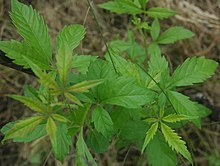Vitex negundo
| Five-leaved chaste tree | |
|---|---|
 |
|
| Scientific classification | |
| Kingdom: | Plantae |
| Clade: | Angiosperms |
| Clade: | Eudicots |
| Clade: | Asterids |
| Order: | Lamiales |
| Family: | Lamiaceae |
| Genus: | Vitex |
| Species: | V. negundo |
| Binomial name | |
|
Vitex negundo L. |
|
| Synonyms | |
|
|
Vitex negundo, commonly known as the Chinese chastetree,five-leaved chaste tree, or horseshoe vitex, is a large aromatic shrub with , densely whitish, tomentose branchlets. It is widely used in folk medicine, particularly in South and Southeast Asia.
Vitex negundo is an erect shrub or small tree growing from 2 to 8 m (6.6 to 26.2 ft) in height. The bark is reddish brown. Its leaves are digitate, with five lanceolate leaflets, sometimes three. Each leaflet is around 4 to 10 cm (1.6 to 3.9 in) in length, with the central leaflet being the largest and possessing a stalk. The leaf edges are toothed or serrated and the bottom surface is covered in hair. The numerous flowers are borne in panicles 10 to 20 cm (3.9 to 7.9 in) in length. Each is around 6 to 7 cm (2.4 to 2.8 in) long and are white to blue in color. The petals are of different lengths, with the middle lower lobe being the longest. Both the corolla and calyx are covered in dense hairs.
The fruit is a succulent drupe, 4 mm (0.16 in) in diameter, rounded to egg-shaped. It is black or purple when ripe.
Vitex negundo is native to tropical Eastern and Southern Africa and Asia. It is widely cultivated and naturalized elsewhere.
Countries it is indigenous to include Afghanistan, Bangladesh, Bhutan, Cambodia, China, India, Indonesia, Japan, Korea, Kenya, Madagascar, Malaysia, Mozambique, Myanmar, Nepal, Pakistan, the Philippines, Sri Lanka, Taiwan, Tanzania, Thailand, and Vietnam.
...
Wikipedia
